Queer Birds of New Zealand
Queer Birds of New Zealand
By
Alexander Lowë
May 2, 2013
Lesbian albatrosses, gay kokakos, bisexual takahe and transgender bellbird - the New Zealand bird community is as unique and diverse as the New Zealand LGBT community. Some birds’ stories are as fascinating as novels, featuring betrayal and devotion, foster parenting, arranged civil unions and forced breakouts. These stories have become intertwined with the history of this country and at times reflect ignorance, misunderstanding and even mistreatment that parallel some of the attitudes towards the Rainbow community.
The news of the 'butch' bellbird found in Karori Zealandia sanctuary near Wellington has flown around the world. The female bird displays a mix of male and female plumage and behaves as a male, making predominantly male calls. Bellbirds are famous for their calls, as Joseph Banks recorded in his notebook during Captain’s Cook first expedition of discovery:
"I was awakened by the singing of the birds ashore, ... They... made, perhaps, the most melodious wild music I have ever heard almost imitating small bells but with the most tunable silver imaginable..."
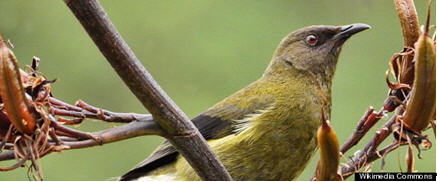
Other than in the Karori sanctuary, the best place to see and hear bellbirds is Tiritiri Matangi island in the Hauraki Gulf, just 50 minutes ferry trip away from downtown Auckland. It was in fact the presence of elsewhere extinct bellbirds on that once barren island that made it chosen to become a model of conservation and a famous bird sanctuary through an extensive regeneration programme.
Among the first birds to be released on Tiri in 1991 were a couple of male Takahe. Another iconic NZ bird, the flightless Takahe were believed to be extinct early last century with the first European settlers only encountering four birds, three of which ended up in museums. One has been attracting thousands of visitors daily in the British Museum (displayed next to a Dodo); another ended up in Frankfurt museum which was destroyed by Allied bombings in World War II, and the last bird was on display in the Otago Museum where it was seen by a young boy George Orwell who got so obsessed with the bird, that he dedicated half of his life trying to find the species in the wild, which he eventually did in 1948 in the snowy Fiordland mountains.
To secure the survival of the shrinking colony after its numbers fell to below 200 birds, some Takahe were transferred to offshore predator-free islands. A couple of Takahe were brought to Tiri in a highly publicized release to enable public access to one of the most famous and rarest birds in the world. It seems to be forgotten now but the celebrity couple was made up of two males, Stormy and Mr Blue - rather an unusual step from DOC to exclude two males from shrinking endangered population, reportedly males were considered to be 'more dispensable'. There was possibly some gender confusion earlier with 'Mr' Blue whose original name Blue was selected in direct reference to the famous 'Old Blue', the sole surviving Black Robin breeding female who is credited for saving her species from extinction. Blue turned Mr Blue was originally expected to do for Takahe survival what Old Blue did for the Black Robins.
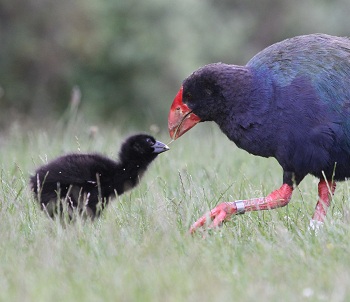
Takahe with a chick
The same sex couple of Takahe was very popular with kids and adults alike; they built a nest and displayed affection and care to each other but alas, they could not breed. The island’s former lighthouse keeper in charge of the birds, inquisitive Ray Walter, put an artificial egg into the nest and was amazed to find the birds taking turns trying to incubate it. He later, in spite of initial DOC opposition, brought from Maud Island a fertile Takahe egg which the surrogate fathers successfully incubated and raised a chick. This experiment revived DOCs interest in Takahe breeding on the island and a single young and beautiful female Takahe named JJ was brought there to shake things up with a bisexual love triangle. Stormy found temptation too strong and eventually went for the younger female bird. Mr Blue was chased away from his prime spot by the lighthouse and crowds of adoring kids, and reportedly got so heartbroken and distressed with the events that he went into hiding. His body was later found in the wetland; contemporaries surmised that he must have 'committed suicide'. Mr Blue was well remembered, though, by kids and adults alike who admired his friendly and inquisitive character and even had a memorial table installed in his honour (another parallel with the Old Blue Black Robin’s story).
Tiritiri Matangi is a special place and I had the privilege of volunteering there along with thousand of other New Zealanders who, over 30 years, planted more than 280,000 trees on the island and facilitated the release of endangered birds. As a guide on the island I was able to see and hear more birds than casual visitors, and my favourites besides the Takahe were the fabulous Kokako birds. These ancient birds have not changed much over the last 60 million years and are closely related to the extinct Huia. They have a special place in both Maori folklore and New Zealand's contemporary history.
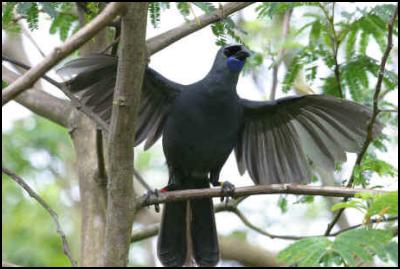
Magnificent Kokako is featured in various Maori legends
In 1978 the first environmental protesters were risking their lives to stop the logging of ancient forest in Pureroa, saving one of the last habitats of Kokako. The surviving magnificent birds reward us with their unique, clear, organ-like call.
What is also rather unusual about Kokako is that they often form male-male couples. During my time on Tiri I was fortunate to have several close encounters with one such couple, males Chinook and Zephyr. These two were virtually inseparable, hopping together from one branch to another and even coming down to the ground in the safety of the predator-free island. (On the mainland Kokakos are very hard to spot hiding far away in the tree tops of kohekohe and kauri). Seeing mythical birds in privacy and close proximity was an incredible life changing experience for me; and witnessing male couple courting each other was uplifting. My memories are bitter sweet, though, as Chinook was later captured and transferred off the island. The same happened to another resident male-male couple; these ‘offenders’ were expelled from the island and transferred to other remote 'camps' apparently in the hope of conversion and subsequent successful breeding.
Similar transfers and enforced separations of male Kokako pairs happened across New Zealand especially in bird sanctuaries such as the Otorohanga Kiwi House. In some places bird transfers resulted in males being outnumbered three times by females so that first female-female couple was recorded while in the wild female numbers are naturally low due to on-.nest predators.
However, most zoos around the world have now abandoned attempts to split same-sex couples, notoriously of penguins, after protests of animal and LGBT rights activists and high profile stories such as that of love birds like Roy and Silo. These penguins in New York City's Central Park Zoo successfully incubated an egg and raised a chick, Tango. It has become common practice in zoos to give male-male penguin pairs a surplus egg from couples who failed to raise two chicks before. This was successfully tried in the United States, Japan, Germany, the Netherlands, Spain and even in communist and gay-unfriendly China.
New Zealand in fact has successful story of foster parenting of endangered birds. Don Merton pioneered cross-species foster parenting and rescued black robins from the brink of extinction, removing eggs of the only surviving breeding pair from the nest and entrusting them to other birds, prompting Old Blue and Old Yellow to have another clutch. Would not this technique work even better within the same species like endangered Kokakos? Kokakos are known to lay up to five clutches when previous eggs fail, and with a shortage of females and the low success rate in multi egg clutches, foster parenting of male couples seems to be an attractive alternative to couple splitting. Video surveillance gave us insight into the private lives of gay kokako and it reveals that there is lots of potential for same sex couple adoption. While in conventional couples it is the female who does nearly all of the nest building and who incubates alone, male-male couples were recorded building nests together and sharing in sitting on the nest even in the absence of eggs. As females are most vulnerable to predators during nesting, gay couple parenting could supplement and lighten up ‘single’ mothers’ efforts.
NZ can be proud of having a wide variety of rather unusual and even unique, native birds. There seem to be, however, some misconceptions, exaggerations or even lies on several NZ websites including DOC’s own website still ignorantly claiming kokako to be the only known bird in the world to form male-male pairs. This is quite a statement as probably most people would immediately think of at least one more species that are common in New Zealand - penguins, where same sex couples have been observed and documented in the wild for decades. In fact, virtually all varieties of penguins - even the rarest yellow-eyed penguins as well as praised after the ‘The March of the Penguins' by moral Christians Imperial Penguins, form same sex couples.
There were also at least three female-female Albatross couples documented in NZ with the last couple successfully raising a chick and making worldwide headlines. And true numbers of 'lesbian' albatross couples might be much higher. Biologist Lindsay Young discovered after DNA analysis that one third of albatross couples in the breeding colony at Kaena Point in Hawaii were lesbian ones. Albatrosses have fooled researchers there for decades as scientists naturally did not expect devoted couples recorded to have been breeding for up to twenty years to be of the same gender. The clues were right in their faces but were misinterpreted: sometimes two eggs were found in the nest while the Hawaiian albatross female is only capable of laying a single egg.
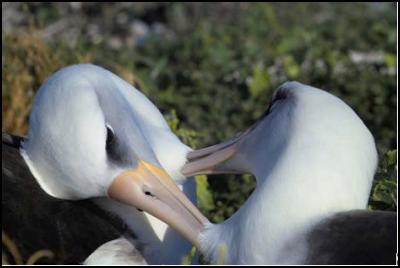
Albatrosses are known to pair for life.
Black swans are increasingly becoming synonymous with gay culture. First Tchaikovsky, then Natalie Portman and recently New Zealand’s own Chris Olwage (ruling Mr. Gay NZ) in ‘New Zealand got talent’ showcased this beautiful bird in the pink light. While female-female swans are rather rare, male pairs of black swans account for up to one fourth of all couples. While female albatrosses have to find ‘donors’ on the side to be able to reproduce, male black swan pairs are reduced to blatant nest stealing as well as kidnapping to be able to build their nuclear family. Or they form threesomes with a female who gets chased away once the eggs are laid. Gay swan couples appear to be rather successful in raising chicks probably due to the ability of an all-male pair to defend bigger territories.
Of course, ornithologists and most other scientists would frown at the application of human related homosexual terms to behavior of other species. It is claimed scientifically birds cannot share human motivation, reasoning, feelings or intentions. We do not really know much about the inner lives of birds and the best we can do is witness their natural behavior and try to learn more about nature itself.
We are most likely to fail trying to project our own beliefs and morals onto animals’ behavior. However heterosexuals also assume that animal species are naturally male-female coupled. There has been very little research in this field of animal same-sex sexual behaviour until recently, and human homosexuality was for centuries claimed to be a ‘sin against nature’. The ‘discovered’ animal homosexuality was used to repeal sodomy laws of 14 states by the United States Supreme court and was also discussed in legislative debates in the Britain Parliament.
Recent discovery of successful and devoted lesbianism in albatrosses became a real embarrassment for Laura Bush who had earlier praised these monogamous birds for their family values. Similarly, Christians have praised the ‘March of the Penguins’ movie ignoring the facts of wide spread male-male coupling among Imperial Penguins.
The story of New York zoo Penguin couple Roy and Silo and their chick Tango was made into a best selling children book; it also became one of the most banned books in the USA. We should also not forget that when she grew up Tango made a couple with another female, yet her dads after several years split up and each paired up with a female penguin.
But how little do they care of what we think of them and how we interpret their behavior? Live and let live. Or live and let die. Take it or leave it; they are who they are. They are simply born this way.
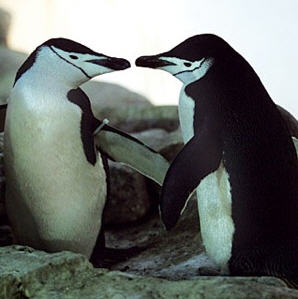
Roy and Silo: It takes two to Tango
ENDS


 Binoy Kampmark: Militarising Europe - The EU Defence Spending Bug
Binoy Kampmark: Militarising Europe - The EU Defence Spending Bug Ian Powell: Brown’s Surgery Puts Health System At Increased Risk
Ian Powell: Brown’s Surgery Puts Health System At Increased Risk Ramzy Baroud: The Monkey’s Tail - How Netanyahu’s Ambitions Expose Israel’s Vulnerabilities
Ramzy Baroud: The Monkey’s Tail - How Netanyahu’s Ambitions Expose Israel’s Vulnerabilities Keith Rankin: Invoking Munich, 'Appeasement', And The 'Lessons Of History'
Keith Rankin: Invoking Munich, 'Appeasement', And The 'Lessons Of History' Peter Dunne: Dunne's Weekly - School Lunches Fiasco Shows What Happens When Social Policy Loses Focus
Peter Dunne: Dunne's Weekly - School Lunches Fiasco Shows What Happens When Social Policy Loses Focus Gordon Campbell: On The Government’s Stubborn Refusal To Invest For Growth
Gordon Campbell: On The Government’s Stubborn Refusal To Invest For Growth